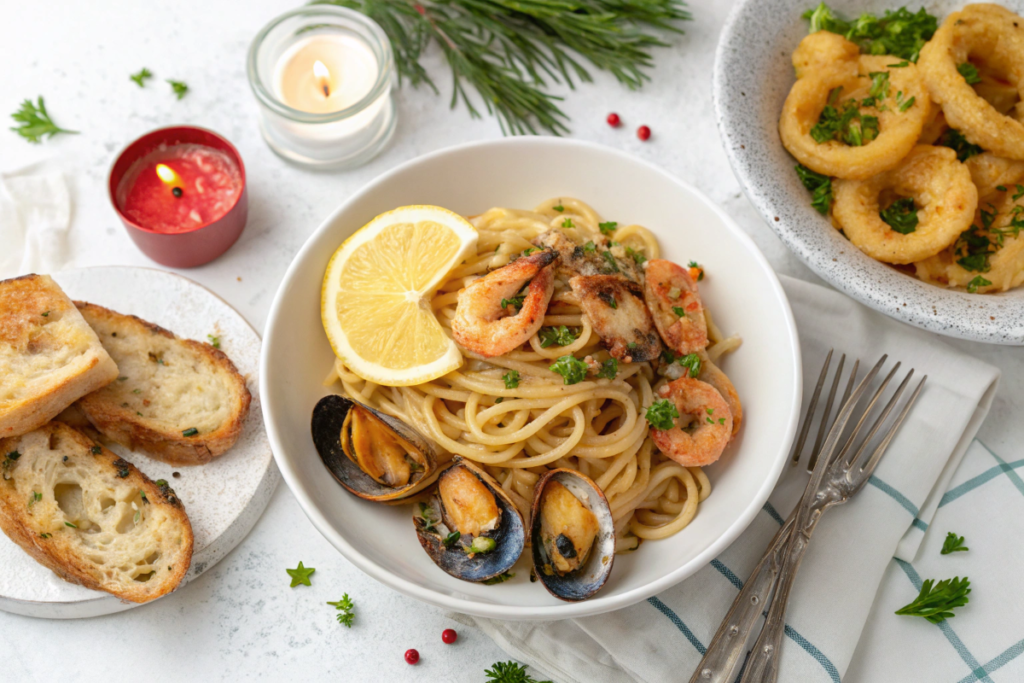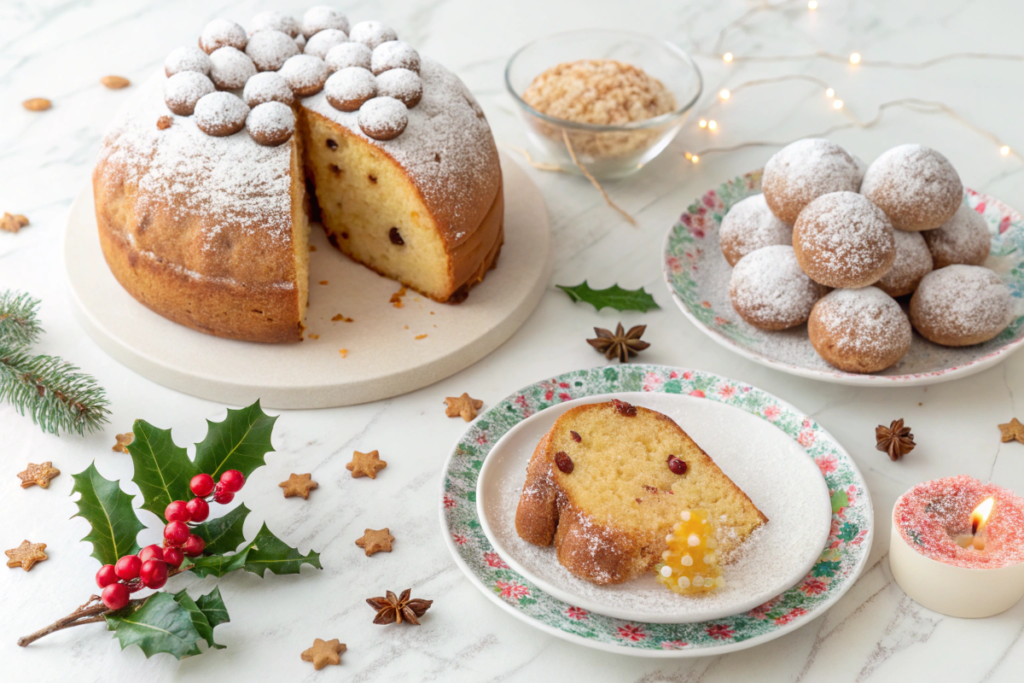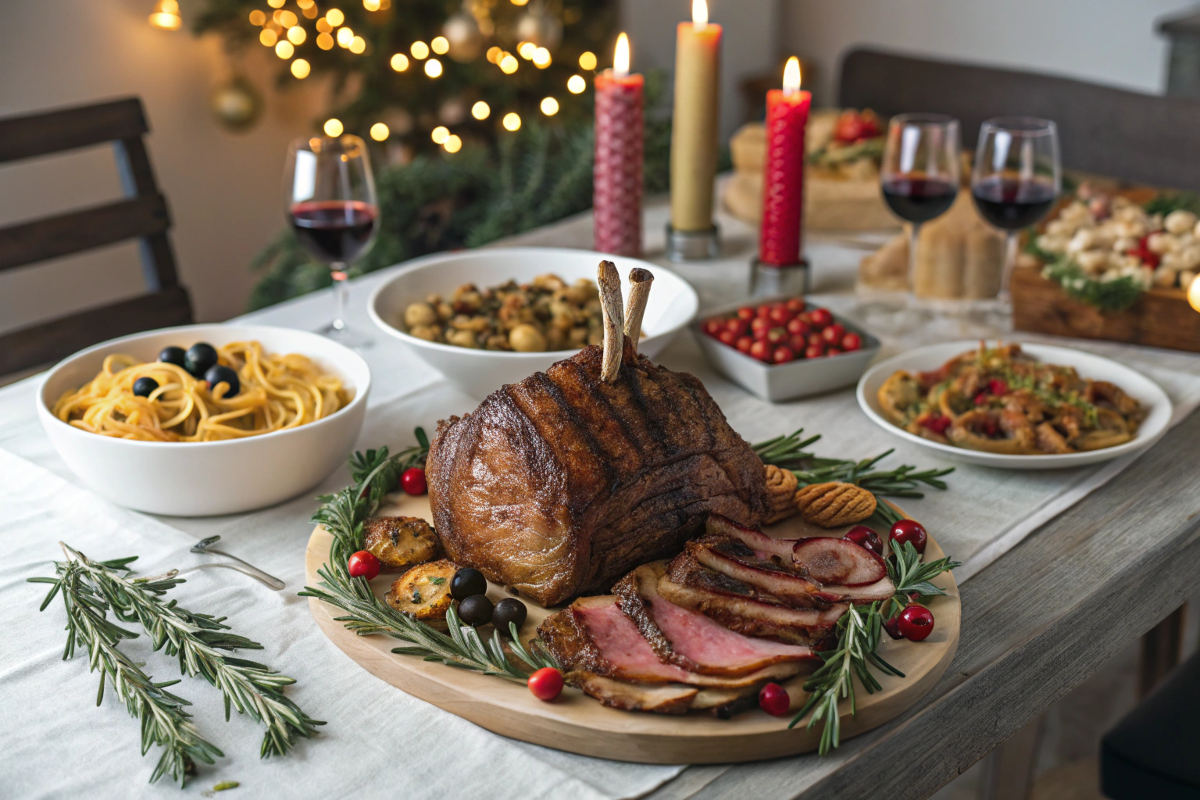The Importance of Christmas Dinner in Italian Culture
A cherished tradition, a traditional Italian Christmas dinner menu is much more than a meal—it brings loved ones together to celebrate faith, love, and culture. As one of the most anticipated events of the holiday season, this feast reflects Italy’s rich culinary diversity and deep-rooted history. For tips on simplifying your holiday preparations, visit How to Make Christmas Dinner Easy.
Historical Origins of Italian Christmas Feasts
How Traditions Developed Over Time
Over the centuries, Italian Christmas feasts have evolved to combine religious practices with local customs. For instance, early Christian celebrations included shared meals to symbolize abundance and gratitude. Later, during the Middle Ages, these feasts grew more elaborate as trade routes introduced new ingredients like spices and dried fruits.
- Medieval Influence: During this period, Christmas dinners became more sophisticated, reflecting Italy’s growing cultural and culinary development.
- Family Gatherings: Additionally, the tradition of uniting as a family on Christmas Eve or Day solidified, emphasizing togetherness and joy.
Influence of Religion and Regional Culture
Religion, especially Catholicism, has shaped many Italian Christmas traditions. For example, families often observe La Vigilia (the Vigil) on Christmas Eve, a seafood-based meal that aligns with Catholic fasting rules. Moreover, regional culture adds variety to these celebrations. Each area incorporates local ingredients and cooking methods, showcasing Italy’s diverse heritage.
Regional Variations in Italian Christmas Menus
Northern Italian Traditions
In Northern Italy, colder climates inspire hearty and warming dishes.
- Popular Dishes: Meals often include risotto with truffles, tortellini in broth, and roasted game meats such as venison or rabbit.
- Desserts: Panettone, a sweet bread filled with candied fruits, is a classic treat originating from Milan.
Southern Italian Specialties
Southern Italy is known for vibrant flavors and fresh ingredients.
- Popular Dishes: La Vigilia features seafood like fried calamari and baked clams, while Christmas Day highlights lamb or goat.
- Desserts: Traditional sweets include struffoli (fried dough balls coated in honey) and cannoli, which are always crowd-pleasers.
Central Italian Culinary Traditions
Central Italy blends northern and southern influences, offering a diverse range of dishes.
- Popular Dishes: Staples include roasted pork, lasagna, and pappardelle with wild boar sauce.
- Desserts: Ricciarelli (almond cookies) and panforte (a fruit and nut cake) add a sweet finish to the meal.
Italian Christmas dinners are a beautiful blend of history, religion, and regional flavors. By embracing both tradition and innovation, these feasts continue to unite families and communities during the holiday season.
Traditional Italian Christmas Eve (La Vigilia) Dinner
La Vigilia, or Christmas Eve dinner, is a cherished Italian tradition rooted in faith and family. Known as the Feast of the Seven Fishes, this meal is a celebration of abundance and gratitude. While seafood takes center stage, there are also delicious vegetarian and non-fish options to accommodate all guests.
The Feast of the Seven Fishes
Symbolism and Religious Significance
The Feast of the Seven Fishes has deep religious meaning, tied to Catholic traditions of fasting and abstaining from meat on holy days. The number seven represents perfection in the Bible, as well as the seven sacraments, making it a significant part of the celebration. This meal allows families to reflect on their faith while enjoying a bounty of fresh seafood dishes.
Popular Fish Dishes and Recipes
A traditional Vigilia table showcases a variety of seafood preparations, each highlighting regional flavors and cooking techniques.
- Baccalà (Salted Cod): Served fried or stewed with tomatoes, olives, and capers.
- Calamari (Squid): Often fried as an appetizer or stuffed with breadcrumbs, herbs, and garlic.
- Linguine with Clams: A pasta dish tossed in olive oil, garlic, and fresh clams for a simple yet elegant flavor.
- Grilled Shrimp or Lobster: Lightly seasoned with lemon and olive oil to highlight the natural sweetness of the seafood.
These dishes bring together family traditions while offering a variety of textures and flavors.
Modern Adaptations
While the traditional Feast of the Seven Fishes remains popular, many families have adapted it to suit contemporary tastes and preferences. Some choose fewer fish dishes for simplicity, while others incorporate international seafood recipes for a modern twist. For example, sushi or ceviche can add a creative and exciting element to the meal.

Vegetarian and Non-Fish Options
For guests who don’t eat seafood, La Vigilia offers plenty of room for creativity.
- Vegetarian Alternatives:
- Eggplant Parmesan: A hearty and flavorful dish layered with tomato sauce, mozzarella, and baked to perfection.
- Mushroom Risotto: Creamy, earthy, and satisfying, this dish is a great centerpiece for non-fish eaters.
- Non-Fish Options:
- Pasta Primavera: Fresh vegetables tossed with olive oil, garlic, and pasta make a simple yet elegant dish.
- Cheese and Herb Tart: A flaky pastry filled with a mix of cheeses and herbs offers a delightful alternative to seafood.
By including these options, hosts can ensure every guest feels welcome and included at the dinner table.
The traditional Italian Christmas Eve dinner is a time to honor faith, family, and culinary heritage. Whether sticking to classic seafood dishes or incorporating modern adaptations, this meal brings loved ones together to celebrate the season in true Italian style.
The Main Christmas Day Feast
In Italy, Christmas Day is marked by a grand feast that brings family and friends together around the table. This multi-course meal is a celebration of rich flavors and culinary traditions, showcasing everything from appetizers to main courses and side dishes.
Antipasti: Starters to Open the Meal
Antipasti, or appetizers, set the stage for the feast with a variety of savory bites that awaken the palate.
- Common Cold Cuts, Cheeses, and Vegetables:
- Cold cuts like prosciutto, salami, and mortadella are popular choices.
- Cheeses such as Parmigiano-Reggiano, mozzarella, and gorgonzola add creamy, tangy flavors.
- Marinated vegetables, including artichokes, roasted peppers, and olives, provide balance and freshness.
- Traditional Recipes for Christmas Antipasti:
- Crostini di Fegato: Toasted bread topped with chicken liver pâté.
- Stuffed mushrooms filled with breadcrumbs, garlic, and parsley.
- Bruschetta with seasonal toppings like roasted tomatoes or fig jam and ricotta.
These antipasti options create a welcoming and festive start to the meal.
Primi Piatti: First Course Options
The primi piatti, or first course, is often a showcase of Italy’s pasta, soup, and risotto traditions.
- Classic Pasta Dishes:
- Lasagna: Layers of pasta, béchamel, ragù, and cheese baked to perfection.
- Ravioli: Handmade pasta pockets filled with ricotta, spinach, or meat.
- Tagliatelle al Tartufo: A luxurious dish featuring pasta tossed with truffle sauce.
- Soups and Risottos:
- Tortellini in Brodo: Small pasta rings filled with meat, served in a flavorful broth.
- Mushroom Risotto: Creamy rice cooked with porcini mushrooms and Parmesan.
These dishes are hearty and warming, making them perfect for a Christmas celebration.
Secondi Piatti: Main Course Options
The secondi piatti, or main course, highlights Italy’s love for flavorful meats and fish.
- Meat Dishes:
- Roasted Lamb: Seasoned with garlic, rosemary, and olive oil for a tender, aromatic dish.
- Beef Braciole: Thin beef rolls stuffed with breadcrumbs, herbs, and cheese, simmered in tomato sauce.
- Porchetta: Slow-roasted pork belly seasoned with fennel and garlic for crispy, flavorful perfection.
- Fish-Based Secondi:
- Baked Sea Bass: Lightly seasoned and baked with lemon, olive oil, and fresh herbs.
- Grilled Swordfish: A simple yet elegant dish served with capers and lemon.
These main courses bring bold flavors and indulgence to the Christmas table.
Contorni: Side Dishes
Italian side dishes, or contorni, complement the main courses with vibrant vegetables and fresh salads.
- Roasted and Sautéed Vegetables:
- Roasted potatoes with rosemary and garlic.
- Sautéed spinach or kale with olive oil and a touch of chili flakes.
- Carrots glazed with honey and balsamic vinegar.
- Classic Italian Salads:
- Caprese Salad: Slices of tomato, mozzarella, and basil drizzled with olive oil.
- Fennel and Orange Salad: A refreshing combination of crunchy fennel and citrus.
These sides add balance and variety, ensuring a well-rounded feast.
The Italian Christmas Day feast is a true celebration of food, family, and tradition. With its carefully curated courses, from antipasti to contorni, this meal captures the joy and abundance of the holiday season.
Italian Christmas Desserts
Italian Christmas desserts are a delightful way to end a holiday meal. They range from traditional sweets that have been enjoyed for generations to modern versions that add a creative touch. These desserts not only bring joy to the table but also highlight Italy’s rich culinary traditions.
Traditional Sweet Treats
Panettone vs. Pandoro
Two iconic Italian Christmas desserts often spark debate: panettone and pandoro.
- Panettone: This sweet bread, filled with candied fruits and raisins, comes from Milan. Its light texture and subtle sweetness make it a favorite for holiday celebrations.
- Pandoro: Unlike panettone, pandoro is a simple star-shaped cake without fruits. Originating in Verona, it offers a buttery flavor and is often dusted with powdered sugar for an elegant finish.
- Choosing Between the Two: While panettone offers a more complex flavor with its fruity filling, pandoro is perfect for those who prefer a simpler, buttery treat.
Torrone, Ricciarelli, and Struffoli
These traditional desserts showcase the variety of Italian Christmas treats.
- Torrone: A nougat made with honey, almonds, and egg whites, often flavored with chocolate or citrus, provides a sweet crunch.
- Ricciarelli: These soft almond cookies, lightly coated with powdered sugar, are a specialty from Tuscany and pair beautifully with coffee or tea.
- Struffoli: Small, fried dough balls coated in honey and colorful sprinkles bring festive flair and sweetness to the table, especially in Naples.
Regional Specialties
Each region in Italy has its own unique Christmas desserts.
- Sicily: Try buccellati (fig-filled cookies) or cassata, a ricotta-filled sponge cake with bright colors.
- Veneto: Fregolotta, a crumbly almond tart, adds texture and flavor.
- Sardinia: Sebadas, a fried pastry filled with pecorino cheese and drizzled with honey, offer a sweet and savory experience.
These specialties add regional flavor and variety to any Italian Christmas celebration.
Modern Christmas Desserts
While traditional desserts remain beloved, modern takes on these sweets bring fresh ideas to the table.
- Tiramisu Variations: Holiday-themed flavors like gingerbread, eggnog, or spiced apple transform the classic tiramisu into a festive dessert.
- Mini Desserts: Bite-sized cannoli, tiramisu cups, or ricotta-filled pastries are not only convenient but also perfect for holiday gatherings.
These modern desserts combine creativity with tradition, ensuring every guest finds something to enjoy.
Italian Christmas desserts blend tradition and innovation to create a memorable end to the holiday meal. Whether you choose a classic panettone or a modern tiramisu, these treats capture the joy and warmth of the season.

Pairing Italian Christmas Dishes with Wines
Pairing the right wine with your Italian Christmas dishes enhances the flavors of your meal and adds a touch of sophistication to the dining experience. From appetizers to desserts, Italy’s diverse wine regions offer perfect options for every course.
Regional Wine Pairings
Best Wines to Complement Specific Courses
Each course in an Italian Christmas meal has its ideal wine pairing, ensuring the flavors shine.
- Antipasti (Starters):
- Light and refreshing wines like Prosecco or Vermentino pair well with cured meats, cheeses, and marinated vegetables.
- For richer starters like crostini with pâté, a medium-bodied white wine such as Soave works beautifully.
- Primi Piatti (First Course):
- Pasta dishes with tomato-based sauces, like lasagna, pair wonderfully with Chianti or Barbera.
- Creamy risottos or pasta with truffles are complemented by a full-bodied white wine like Chardonnay or a light red like Pinot Nero.
- Secondi Piatti (Main Course):
- Roasted lamb, beef, or pork pairs perfectly with bold red wines such as Barolo or Brunello di Montalcino.
- For fish-based main courses, crisp whites like Greco di Tufo or Fiano are excellent choices.
By choosing wines that match the flavor profile of each course, you can elevate the overall dining experience.
Dessert Wine Recommendations
No Italian Christmas feast is complete without a sweet wine to accompany the desserts.
- Panettone and Pandoro: Pair these classic holiday cakes with Moscato d’Asti, a lightly sparkling and sweet wine that balances their richness.
- Torrone or Ricciarelli: A glass of Vin Santo, with its nutty and caramel notes, enhances almond-based treats like these.
- Chocolate Desserts: Opt for a bold, sweet red like Recioto della Valpolicella or a classic Italian dessert wine like Passito.
These dessert wines provide the perfect ending to a festive meal, complementing the sweet flavors without overwhelming them.
Pairing Italian Christmas dishes with wines adds depth and harmony to your holiday table. Whether you’re serving antipasti, hearty main courses, or sweet desserts, the right wine can make every bite even more memorable.
FAQs About Traditional Italian Christmas Dinner Menu
Are Italian Christmas Dinners Expensive to Prepare?
It depends on your choices, but using seasonal ingredients and simpler dishes can keep costs reasonable.
Can I Create a Vegetarian Version of a Traditional Menu?
Yes, you can substitute meat dishes with vegetarian lasagna, stuffed vegetables, or mushroom risotto.
What Are the Best Wines to Serve at Christmas?
Chianti, Prosecco, and Moscato d’Asti are versatile options that pair well with various courses.
Conclusion
Pairing the right wines with your Italian Christmas dishes enhances the flavors of every course and elevates your holiday meal. Whether you choose regional wines for antipasti and main courses or sweet dessert wines for panettone and torrone, thoughtful pairings add a touch of elegance to your celebration. By embracing Italy’s rich wine traditions, you can create a dining experience that your guests will remember and cherish.

